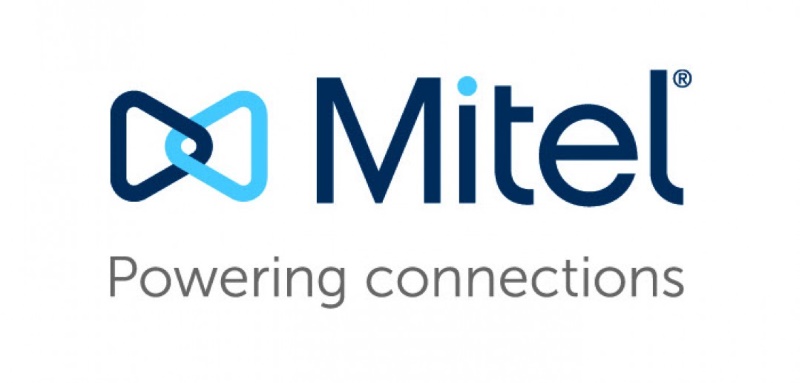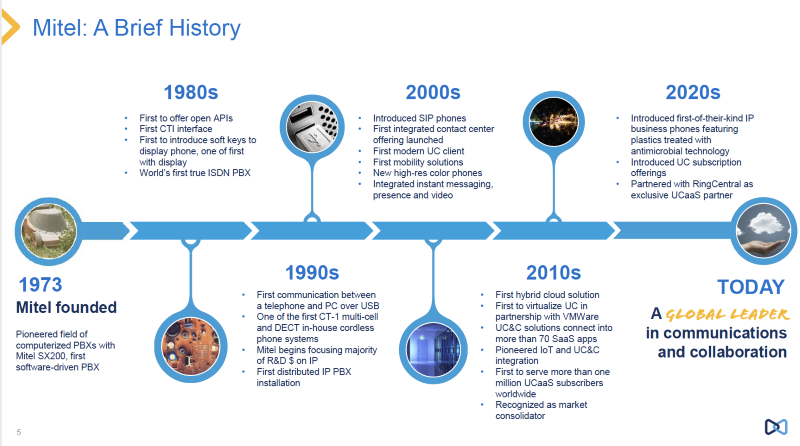Mitel deserves to be applauded for being a backbone for enabling crucial communications for all business sides across the verticals for decades.

On June 8, 1973, Mike Cowpland and Terry Matthews embarked on a new adventure. The pair had departed Bell Northern Research (BNR) with a non-compete in hand, so instead of creating a telecom company, they founded Mike and Terry Lawnmowers, also known as Mitel. There is some debate as to whether Mitel shipped any lawnmowers, but the one thing that is known is that shortly after, the clock ran out on the non-compete. The newly formed telecom company started competing for business with BNR, and the company we all know as Mitel was born.
As an analyst, I have had a long history with Mitel and have seen the company go through many ups and downs, but throughout it all, I’ve also found Mitel to be very innovative. The image below, from Mitel, shows most of their firsts or near firsts, throughout the years. Below are the notable ones I remember; some are on here, and some are not.

First Auto-VPN phone
In the early 2000s, Mitel released a telecommuter phone that, when plugged into the network, would automatically connect to the company headquarters system. Mitel’s then head of strategic marketing, the late Simon Gwatkin, sent several out to different analysts. I recall plugging it in, having it come online in a few minutes, and instantly having the ability to four digital dial Gwatkin and many UC analysts.
First PBX Vendor to Embrace IP
When upstart companies like Cisco and 3Com started selling IP systems, most “legacy” vendors half-heartedly supported the trend by IP enabling their TDM PBX. I recall being at Mitel’s HQ when then CEO, Don Smith, told a group of analysts that the company would be diverting most of its R&D to IP systems. He believed IP was the future and let the company’s money do the talking.
Released the Navigator Phone “Bar”
In the mid-2000s, Mitel unveiled a bar that clipped to the bottom of a monitor to replace the desk phone. At the time, Mitel also sold turrets into the financial services industry, and the Navigator was designed for telephony-heavy workers that needed space on their desks, like call centers. The product flopped, but what I liked about it is that Mitel understood that telephony could be delivered in alternative form factors. PC calling is proof of that, but Mitel was far too early to market.
First to Virtualize its IP PBX
Late in the decade of the 2000s, Mitel ported its IP PBX to run VMware’s virtual machines. At the time, there was great skepticism about virtualizing call control. I recall being told several times it could not be done. That year, Mitel appeared as an exhibitor at VMworld and demonstrated that it could work, and today, every vendor supports VMware. In the mid-2000s, Mitel was also the first to operate in hybrid cloud mode.
Led the integrated UC / CC industry vision
In 2013 Mitel acquired contact center provider, PrarieFyre and then in 2014 bought Oaysis, a supplier of call recording and quality metric tools for contact centers. Shortly after that Mitel began evangelizing the concept of integrated UC/CC. PrarieFyre was a good product for small businesses but could not help Mitel with its move into larger companies.
First to support Microsoft
Shortly after Microsoft launched Live Communication Server (LCS), Mitel announced a partnership with them. Microsoft’s technology was unproven, but Mitel was banking that the Redmond-based software company would make a dent in the industry. LCS, which became OCS flopped and then Microsoft eventually acquired Skype to bolster its call control. Had LCS worked, who knows where the partnership may have led.
Buying Mavenir
The Mavenir acquisition was the right move but a decade too early. In 2015, Mitel ponied up $650M to buy Mavenir, a manufacturer of telco-based mobile infrastructure. At the time, the deal left many scratching their heads, but then CEO Rich McBee, had the vision of building unified communications (UC) and/or contact center (CC) capabilities directly into the mobile network. The vision was right, as mobile integration is now a reality (which is why Ericsson bought Vonage). Mitel’s Mavenir purchase didn’t work out because the market wasn’t ready, and mobile networks were not yet cloud-native, making integration slow and time-consuming.
Enterprise Acquisitions
Under McBee, Mitel began rolling up the enterprise communications space when it purchased Aastra and then ShoreTel. The former gave Mitel share, and ShoreTel was designed to let Mitel jump-start its cloud business. The vision was right, but ShoreTel’s cloud platform, Sky, had reliability and scale issues. If Sky had worked as advertised, Mitel could have been one of the market leaders in unified communications as a service (UCaaS).
Fifty Years Later…
Today, after 50 years, the company focuses on what it does best: building innovative unified communications (UC) solutions. While UCaaS captures many headlines, UC remains a massive market for the foreseeable future, where Mitel acts as a clear leader and consolidator. Like everyone else, the company has had its share of successes and misses. Still,
I’m looking forward to seeing what the next decade brings.
Happy 50th Birthday Mitel.